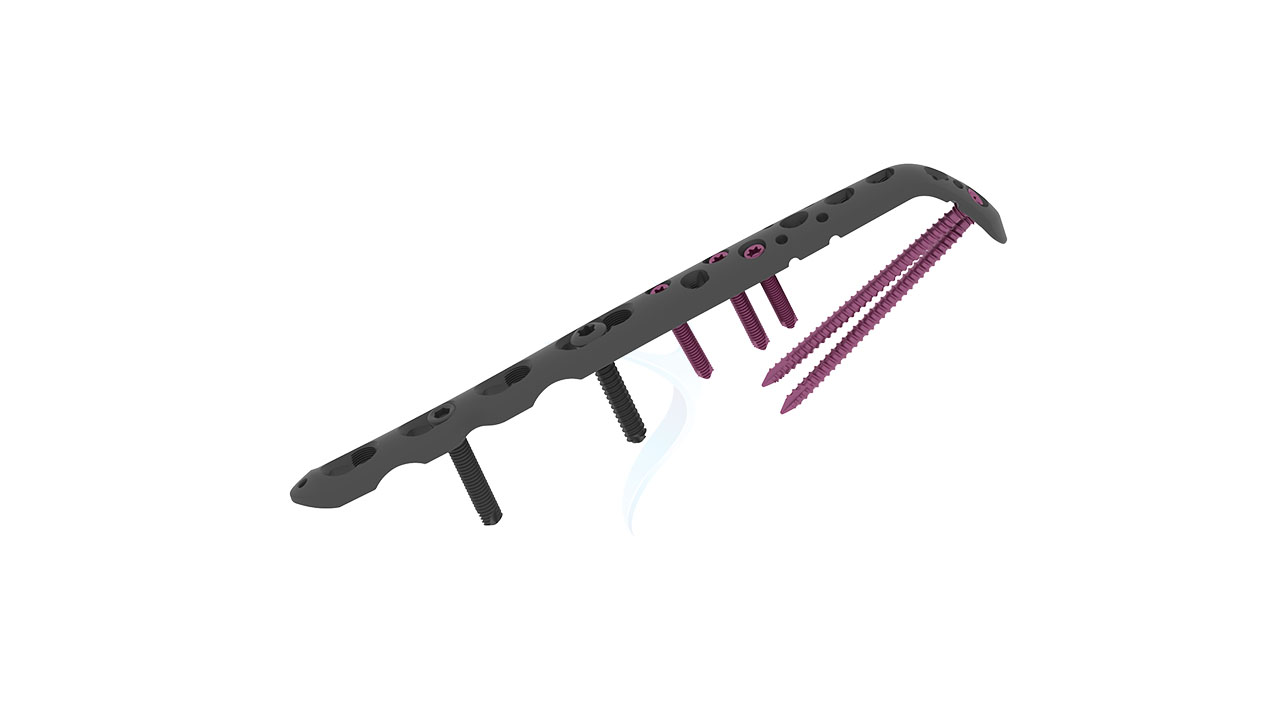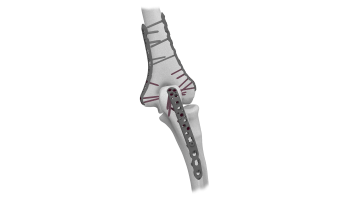Elbow Plate (VALP)- 2.7 / 3.5 Olecranon
Product Overview
The 2.7 / 3.5 Olecranon Plate - VALP is a cutting-edge orthopedic implant designed for superior fixation of olecranon fractures. Crafted with precision engineering and advanced materials, it offers optimal stability and support for efficient healing. Its versatile design ensures compatibility with various anatomies, providing surgeons with flexibility during procedures. Trust in VALP for reliable performance and patient satisfaction in orthopedic care.









Product Uses
- Olecranon Fractures : Provides stable fixation for fractures of the olecranon, ensuring proper alignment and support for optimal healing.
- Osteotomies : Facilitates precise osteotomies of the olecranon with reliable fixation, aiding in corrective surgeries.
- Non-union or Malunion : Corrects non-union or malunion of olecranon fractures by securely stabilizing the bone fragments.
- Revision surgery : Used in revision surgeries to address failed previous fixations or complications in olecranon fractures.
- Trauma Cases : Suitable for traumatic injuries involving the olecranon, offering dependable fixation to restore function and stability.
- Orthopedic Reconstruction : Integral in orthopedic reconstruction procedures aiming to restore the integrity and function of the elbow joint.
Product Specification
- Size : Available in 2.7 mm and 3.5 mm thickness options to accommodate varying patient anatomies and surgical needs.
- Material : Constructed from high-quality medical-grade stainless steel or titanium alloy for durability, biocompatibility, and corrosion resistance.
- Design : Features a low-profile, anatomically contoured plate design to minimize soft tissue irritation and optimize bone contact for enhanced stability.
- Screw Holes : Multiple screw holes along the plate allow for versatile screw placement, enabling customized fixation based on fracture patterns and bone quality.
- Locking Mechanism : Incorporates locking screw technology for enhanced stability and angular stability, reducing the risk of screw loosening or backing out.
- Compatibility : Compatible with standard orthopedic instruments and techniques, facilitating seamless integration into existing surgical protocols.
Elbow Plate (VALP)- 2.7 / 3.5 Olecranon Sizes
Comprehensive Guide for Elbow Plate (VALP)- 2.7 / 3.5 Olecranon
- Patient Evaluation : Review the patient's medical history, conduct a physical examination, and order relevant imaging studies (X-rays, CT scans) to assess the olecranon fracture.
- Surgical Planning : Analyze the fracture pattern and determine the appropriate size of the 2.7 / 3.5 Olecranon Plate - VALP, as well as the number and placement of screws required for fixation.
- Informed Consent : Discuss the surgical procedure, potential risks, benefits, and alternatives with the patient, ensuring informed consent.
- Pre-operative Optimization : Optimize the patient's medical condition, including managing comorbidities, adjusting medications, and addressing any nutritional deficiencies.
- Antibiotic Prophylaxis : Administer prophylactic antibiotics according to institutional guidelines to reduce the risk of surgical site infection.
- Skin Preparation : Cleanse the surgical site with antiseptic solution to minimize the risk of contamination.
- Patient Positioning : Position the patient supine or in a lateral decubitus position, with the affected arm on a hand table or arm board.
- Incision : Make a longitudinal or curvilinear incision overlying the olecranon, exposing the fracture site while preserving soft tissue integrity.
- Fracture Reduction : Carefully mobilize the fracture fragments and achieve anatomical reduction using manual manipulation, bone clamps, or reduction forceps.
- Plate Placement : Select the appropriate size of the 2.7 / 3.5 Olecranon Plate - VALP and position it over the dorsal aspect of the olecranon, ensuring proper alignment with the bone.
- Screw Fixation : Secure the plate to the olecranon using locking or non-locking screws, ensuring adequate purchase in the bone while avoiding joint penetration.
- Wound Closure : Close the incision in layers, ensuring hemostasis and meticulous closure of the subcutaneous and skin layers.
- Pain Management : Provide adequate pain relief using multimodal analgesia to ensure patient comfort.
- Early Mobilization : Encourage early mobilization and range of motion exercises of the elbow joint under the guidance of a physiotherapist.
- Wound Care : Instruct the patient on proper wound care, including keeping the incision site clean and dry, and monitoring for signs of infection.
- Follow-up : Schedule follow-up appointments to monitor the patient's progress, assess healing, and remove sutures or staples as necessary.
- Rehabilitation : Implement a comprehensive rehabilitation program focused on restoring strength, mobility, and function of the elbow joint.
- Activity Restrictions : Advise the patient on activity restrictions, including limitations on heavy lifting and strenuous activities, to prevent implant failure or complications.










.png)




